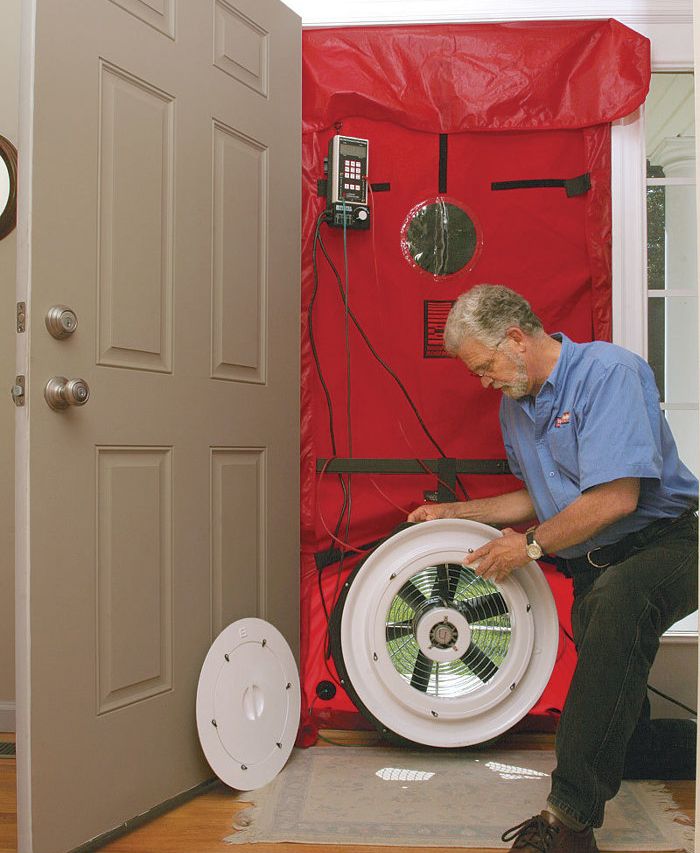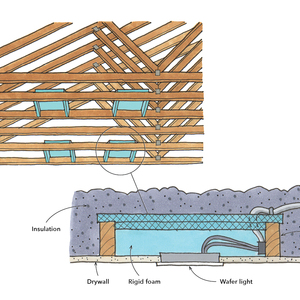Blower-Door Testing Basics
Get ready: Airtightness requirements are part of the 2012 building and energy code.

Synopisis: Airtightness will be a watchword in the coming years as the requirements of the 2012 International Residential Code (IRC) are put into practice. Building-science educator, Larry Armanda, gives a detailed account of how airtightness is measured, and the standards that must be adhered to. A blower door has a powerful variable-speed fan and a two-channel digital manometer, or air-pressure gauge. After being temporarily installed in an exterior door opening and turned on, it draws air from the house and blows it outside. The manometer measures both inside and outside air pressure. The idea is to register the difference between the inside and outside air pressure using the blower door’s fan. The amount of air and fan power that it takes to register the difference corresponds to how tight or how leaky the house is.
Air leaks in houses are a big problem. Leaks make homes uncomfortable and expensive to heat and cool. They create condensing cold spots that attract mold and rot. They lead to frozen pipes and make homes less resilient during prolonged power outages.
Dealing with air leaks starts with locating them. There are many ways to find air leaks; the easiest and most common is to use a blower door. Blower-door tests used to be the exclusive domain of weatherization workers and building-science geeks, but that’s not the case anymore. Everyone involved in residential building needs to become more familiar with blower-door testing because universal testing for all new homes is coming.
Section N1102.4.1 of the 2012 International Residential Code (IRC) includes a requirement for blower-door testing with airtightness standards spelled out for the country’s various climate zones. New houses will need to meet or exceed these airtightness numbers to meet the current building code. It’s not clear who will do the testing, however. Some code-enforcement offices let contractors do their own blower-door tests. Others require third-party testing. It seems likely that some will have their inspectors do the testing.
How does a blower door work?
A blower door has a powerful variable-speed fan and a two-channel digital manometer, or air-pressure gauge. After being temporarily installed in an exterior door opening and turned on, it draws air from the house and blows it outside. The manometer measures both inside and outside air pressure.
For most of the tests, the idea is to register a 50-pascal (Pa) difference between the inside and outside air pressure using the blower door’s 3⁄4-hp fan. The amount of air and fan power that it takes to register the 50-Pa difference corresponds to how tight or how leaky the house is.
You can adjust the fan speed with the sensitive electronic speed controller and match the fan size to the expected leakiness of the building with a series of flow rings that adjust the size of the fan inlet.
What the numbers mean
The results of most blower-door tests are expressed in cfm50 (cubic feet per minute at –50 Pa) or in ACH50 (air changes per hour at –50 Pa). A 50-Pa difference is roughly the equivalent of a 20-mph wind on all sides of the house. The intense pressure from the blower door exaggerates the natural conditions to make air leaks appear more obvious.
The cfm50 measurement refers to how much air is rushing back into the building as the blower door is forcing air out, depressurizing the house. A good number here would be about 800 cfm50 or 900 cfm50 for a 2000-sq.-ft. house.
For more photos and details, click the View PDF button below:


























